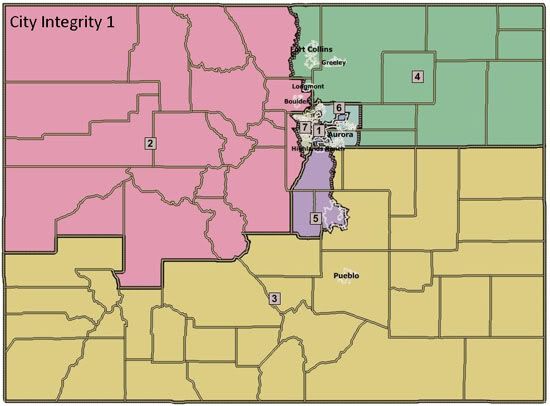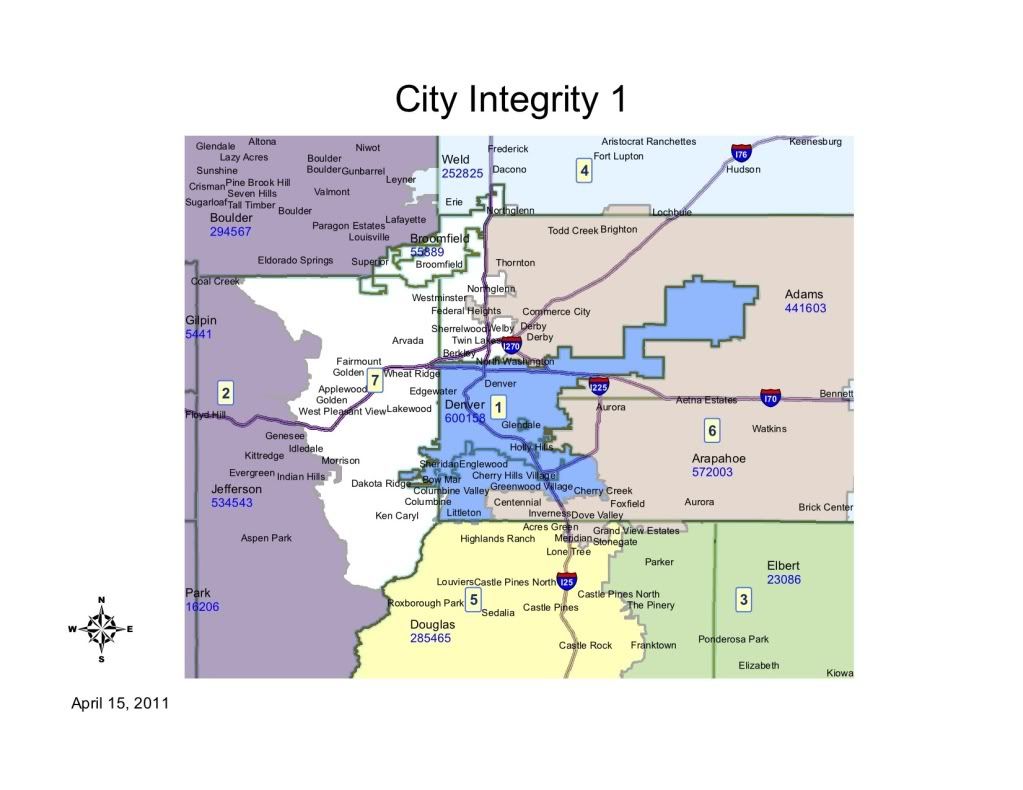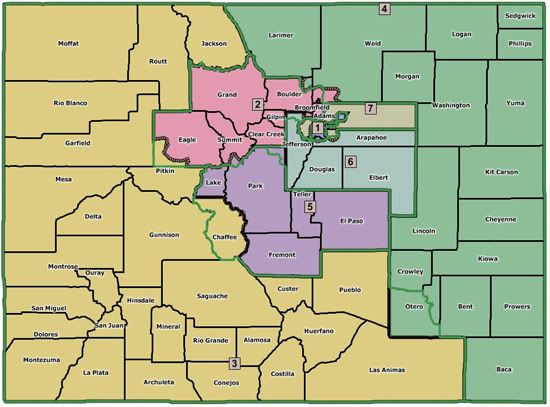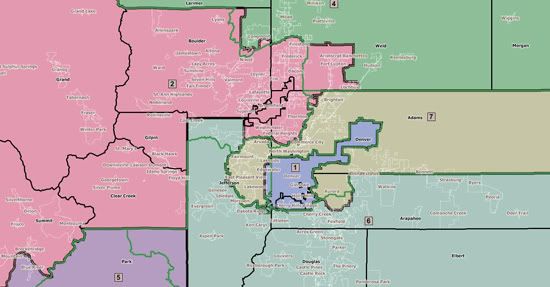Yesterday afternoon the 12 maps were released by the Joint Committee on Redistricting. The committee has also been tagged as the “Kumbaya Committee” for it’s attempt to bring bipartisanshippyness to the most partisan issue possible.
Of the 12 maps, 6 were brought forward by the Democrats on the Committee and 6 from the Republicans. All 6 Democratic maps followed a similar pattern of keeping whole cities intact as well as entire rural counties and were appropriately named “city integrity”. The Republican maps all stayed close to the current map, probably realizing that’s the best deal they could get at this point.
Several of the changes from both maps incorporated the wishes of different constituencies in the hearings the committee held all over the state. The biggest wish “Keep us separate from Boulder.” Other major wishes included putting Grand and Chaffee counties in the 3rd (or at least not in their current 2nd and 5th CDs) and keeping the city and county of Denver whole (which is a shame).
I’ve only included 1 map from each side as the other 5 on both sides are similar to them and change only a county or city here and there.
City Integrity 1
First, the Democrats map, known as “City Integrity 1.” This is my personal favorite of all the Democratic maps and it’s also the “cleanest map” according to Sen. Rollie Heath (D-Boulder), co-chair of the committee. All of the “City Integrity” maps strived to follow transportation corridors as well as striving for competitiveness. The 1st, 2nd and 7th CDs are consistent throughout all the Democratic maps.
1st CD: The 1st CD probably has the fewest changes. It contains all of Denver County, Englewood, Cherry Hills Village, and Sheridan as before. It adds Littleton, Greenwood Village, Bowmar, Cherry Creek Reservoir and some surrounding unincorporated areas of Arapahoe County. The additions to the district are more Republican than the district as a whole, but the changes should be minimal, just making the district somewhat whiter than before.
2nd CD: The 2nd CD has some radical changes, going from it’s base in Boulder County (minus Longmont and Erie) west to take in all the north-west corner of the state. The biggest new addition is Mesa County, one of the most Republican counties in the state and now the 2nd largest county in the district. Chaffee, Lake and Park were taken from the 5th (as requested by the residents of Lake and Chaffee. The district now includes all the major ski towns, Aspen, the oil and gas counties and the foothills towns in western Jefferson County. If nothing else the district is now much more diverse in it’s interests and much more Republican. The party break down is now 31 D, 31 R and 26 U, much more similar to the 7th CD when it was drawn a decade ago to be the most competitive. We should be thankful Polis has more money than God and can probably hold this district in a non-2010 year.
3rd CD: The biggest disappointment of this map (especially to House Minority Leader Sal Pace of Pueblo) is the new 3rd CD. It does a great job of keeping together the communities of interest in southern Colorado (despite what Republicans say, the south has more in common than the western slope and eastern plains as a whole). It still contains all of Pueblo, but also adds Fremont, the rest of Otero, all the rural plains counties south of I-70 and the non-Colorado Springs portions of El Paso county, as well Parker and rural parts of Douglas county. Overall this makes for a much more Republican district, probably out of reach for Democrats, but if you had to cut one loose, this was probably the district to do it with as several of the blue areas are shifting more and more R every year (San Luis Valley, Pueblo, Las Animas, Huerfano). It still keeps Rep. Tipton’s home in Montrose so he can’t be too disappointed.
4th CD: The 4th CD needed to lose population and it did it with the most Republican parts of the district, now ending at Arapahoe/Washington/Yuma rather than taking in all the eastern plains down to the New Mexico Border. It also loses the western half of Larimer County to the 2nd. Most of the population lives in eastern Larimer so not much change other than shedding many republican precincts. It then adds Erie and the eastern portions of Adams and Arapahoe counties, which are republican but not nearly as much as the counties given up. These changes probably produce a district Obama and McCain were even in, if not a slight Obama win. It becomes more winnable for Democrats, but still very competitive. Sen. President Brandon Shaffer (D-Longmont) has to be pleased with this map as it keeps him in the district for a potential run. Rep. Cory Gardner would not be happy at all with this district, but definitely still won it in it’s new configuration and the district keeps his home in Yuma.
5th CD: Officially the southern I-25 corridor district, the 5th probably becomes even more Republican, adding most of Douglas, while shedding the swingier Chaffee and the blue Lake County. Maintaining the home of Rep. Lamborn and also maintaing the districts center of gravity in Colorado Springs, the district will be to his liking (except for the absence of Fort Carson, which is now in the 3rd). This is the beginning of the screwing-over of Rep. Coffman by taking out his best area in Douglas.
6th CD: The best change this map makes is the changing of the 6th from a suburban-Republican stronghold to a swingy eastern-suburban district. While it keeps Coffman’s home in Aurora, he’s basically screwed in this district. The extent to which this district takes in parts of Douglas and/or Weld changes between maps, but the heart of the district is the Arapahoe suburbs not in the 1st and most of the Adams Co. suburbs, including all the most hispanic areas. Obama certainly won this district and in any normal year it would elect a solid Dem candidate. This is probably the biggest reason this map will never be acceptable to the Republican House (while they have no love for Coffman I can’t see them being this willing to give up a safe seat).
7th CD: Another great change is in the 7th CD. Keeping it’s base in Jefferson County, it sheds most of it’s Adams Co. areas and all of Aurora. It then adds all of Arvada, Westminster, Northglenn and Broomfield (formerly in the 2nd). It also takes in the Ken Caryl and unincorporated Jeffco (sometimes referred to as part of Littleton). The district probably doesn’t change much in it’s tilt (maybe a very slight shift to the right), but it does remove the possibility of a Ryan Frasier challenge as he lives in Aurora. This district makes more sense, while also maintaining it’s competitiveness.
Balmer Map 1
The first Republican Map, known as “Balmer Map 1” for it’s author Rep. Balmer (R-Foxfield). It is typical of all the Republican maps, keeping to the current boundaries as much as possible. The biggest changes are the removal of Chaffee county from the 5th, the rest of Otero county in the 4th and more of Weld into the 2nd and southern Aurora into the 7th.
The map below has helpful green lines where the current districts are so you can track the changes.
1st CD: Few changes here, but to add population the lines were moved from the county line between Denver to Jefferson (Sheridan Blvd.) to Wadsworth Blvd., all the precincts in between include parts Wheat Ridge and Lakewood and are probably some of the most Democratic precincts in Jefferson county. The district remains as Democratic as before.
2nd CD: Biggest changes here were putting south-west Eagle County into the 3rd, a sliver of summit into the 5th to balance population there and the addition of Fort Lupton in Weld County. The meter will be moved very little here either.
3rd CD: The addition of Chaffee county is the biggest change along with the removal of the rest of Otero. Little change here, but maybe a smidge in the Democratic direction.
4th CD: Only the addition of the rest of Otero and the removal of Fort Lupton, doubtful to have much impact on the partisan make up.
5th CD: Removal of Chaffee county and the addition of the rest of Park and the Summit County Sliver, making it just a point or 2 more Republican.
6th CD: While appearing to have little change, the 6th actually has the most radical change in that it removed Rep. Coffman’s home in southern Aurora and puts it in the 7th! Coffman has already reacted to the maps, lashing out at the Democratic maps for not including his home in his current district, when in fact they do… But he plans to move to Greenwood Village, so he is actually angry at his future home being removed from the district and isn’t mad at the Republicans at all for screwing out of a district in their maps. Gotta love that!
7th CD: Almost no change, except now being the home to Rep. Coffman!
Likely result
Unless the “Kumbaya Committee” suddenly has a desire to actually work together, looks like neither of these maps or any of the other 10 maps will make it. The rural Republicans are already screaming about the dividing of the eastern plains and western slope, which they consider to be “communities of interest.” So we’re more likely than not to have the issue before the courts. Lucky for Dems the Colorado Supreme Court is packed with Democratic-appointed Justices and in 2000 they chose the current map, which was proposed by Democrats.




With a 5-1-1 advantage at the Co Supreme Court (Coats and Eid being the only ones swinging right with any regularity), they know throwing it to the Courts means a Dem-leaning map. Not giving the Republicans an “out” with a compromise map was a smart political move.
I’m not a huge Rep. Pace fan, so I’m kinda happy the Dems didn’t preference him for their map. Lamborn and Tipton probably stay in Congress for a long time under these maps (though, someone like Sen. Gail Schwartz could make a run at Tipton in this new CD-3, even if it’d be uphill).
CD-2 gives me some pause; I love the idea of Mesa County being represented by a gay Democrat, but this is an opening for Josh Penry to try and move up. I don’t think he’d beat Polis, but it’d be closer than we’d like (and remember, Polis only won his “safe” district by 11 in 2008 against Some Dude).
I’m still digesting the maps, but I think something near to Dem Map #1 will be eventually picked by the CO Supremes.
As it stands, there are two safe-Dem districts, two safe-GOP districts, one lean-Dem district (which is threatening to become safe-Dem), and two lean-GOP districts. At first glance, it appears like we’ve really weakened Polis by having him take in so much rural territory, but most of those counties have very small population and several are actually Dem-leaning. Boulder should very easily outweigh the influence of Mesa County and it should stay safe Dem.
So by taking Mesa out of the Pueblo-based 3rd, you’d think we’d have a better shot at retaking that district, but instead they dump GOP-strongholds Fremont and Elbert in there in its place and basically assures that it continues to be a lean-GOP district.
I like everything else though. CO-07 becomes safer for Perlmutter without wasting too many Dem votes, and the real genius move is packing Colorado Springs and Castle Rock (El Paso and Douglas counties) together for one super-GOP district that essentially combines the two safe-GOP districts.
End result, we are favored in four districts, with the distinct possibility of winning two more and having a 6-1 split.
The fact that the GOP map is so tame in comparison is an illustration of how good the current map is for them.
should be fine. Many of the new additions to his district like Steamboat Springs, Vail, Aspen etc are extremely liberal and balance out Mesa. I doubt the PVI of his district would even be shifted much under this proposal and it could easily take in more GOP areas.
Let’s put it this way: ideally I would have CO-3 take in the ski areas and have Polis take in Mesa and the outlying areas that contain ultra-GOP strongholds thanks to the uranium mining industry. It would obviously be a gerrymander and Polis could have some trouble in a only D+4 or D+5 district. CO-3 however would be R +2 or R+3, easily good enough for Salazar to mount a comeback.
If the Dem’s map were to remain in-tact:
1st District: Rep. DeGette vs. Sacrificial Lamb (R-Cherry Hills Village)
2nd District: Rep. Polis vs. former State Senate Minority Leader Josh Penry (R-Grand Junction)
3rd District: Rep. Tipton vs. no serious opponent…weird that the D’s want to give the weakest Republican in the delegation a free pass for a decade.
4th District: Rep. Gardner vs. State Senate President Brandon Shaffer (D-Longmont)…in an potentially epic match up. I am suprised the D’s didn’t try to tweak this district further to make it a more even playing field, especially considering Gardner is the biggest threat from a state-wide perspective.
5th District: Rep. Lamborn vs. whomever draws the short straw at the El-Paso County Democrats annual picnic
6th District: Rep. Coffman vs. State Sen. Morgan Carroll (D-Aurora)
7th District Rep. Perlmutter vs. Senate Minority Leader Mike Kopp (R-Littleton)…While not putting him in imminent danger, the new district does not do Perlmutter any favors either. So this could be a competetive race if it materializes.
Great diary btw Larimer…spot on analysis
The whole point of these maps is to start out with an extreme position, so that you end up with something like this through compromise and negotiation. (see GOP budget) The Polis district was a terrible idea. We could just combine Boulder, Fort Collins, and Greeley in 1 extremely liberal district and combine the Eastern Plains and Western Slope (excluding Grand Junction) into a huge GOP vote sink. We could then just add the ski towns into the 3rd, which would offset Grand Junction and give us one more rural district that would be able to last at least a decade before it goes red, like the Georgia Dems did in 2002 with Jim Marshall, who lasted until 2010 even after the Republicans tore up his district in 2004.